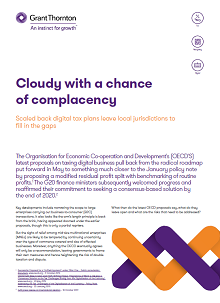-
Accounting Advisory
Our accounting advisory team help businesses meet their complex financial reporting requirements. The team can support in applying new financial reporting standards, IFRS/ US GAAP conversions, financial statement preparation, consolidation and more.
-
Payroll
Our team can handle your payroll processing needs to help you reduce cost and saves time so that you can focus on your core competencies
-
Managed accounting and bookkeeping
Outsourcing the financial reporting function is a growing trend among middle market and startup companies, as it provides a cost-effective way to improve the finance and accounting function. Our team can help with financial statement preparation, consolidation and technical on-call advisory.
-
Accounting Advisory
Our team helps companies keep up with changes to international and domestic financial reporting standards so that they have the right accounting policies and operating models to prevent unexpected surprises.
-
Crypto Accounting Advisory Service
Our team can help you explore appropriate accounting treatment for accounting for holdings in cryptocurrencies, issuance of cryptocurrencies and other crypto/blockchain related accounting issues.
-
ESG Reporting and Accounting
As part of our ESG and Sustainability Services, our team will work with you on various aspects of ESG accounting and ESG reporting so that your business can be pursue a sustainable future.
-
Expected Credit Loss
Our team of ECL modelling specialists combine help clients implement provisioning methodology and processes which are right for them.
-
Finance Transformation
Our Finance Transformation services are designed to challenge the status quo and enable your finance team to play a more strategic role in the organisation.
-
Managed Accounting and Bookkeeping Services
Outsourcing the financial reporting function is a growing trend among middle market and startup companies, as it provides a cost-effective way to improve the finance and accounting function. Our team can help with financial statement preparation, consolidation and technical on-call advisory.
-
Business Tax Advisory
Our business tax team can help you navigate the international tax landscape, grow through mergers and acquisitions, or plan an exit strategy.
-
Corporate Finance
Our corporate finance team helps companies with capital raising, mergers and acquisitions, private equity, strategic joint ventures, special situations and more.
-
Financial Due Diligence
From exploring the strategic options available to businesses and shareholders through to advising and project managing the chosen solution, our team provide a truly integrated offering
-
Valuations
Our valuation specialists blend technical expertise with a pragmatic outlook to deliver support in financial reporting, transactions, restructuring, and disputes.

-
Sustainability with the ARC framework
Backed by the CTC Grant, businesses can tap on the ARC Framework to gain access to sustainability internally, transform business processes, redefine job roles for workers, and enhance productivity. Companies can leverage this grant to drive workforce and enterprise transformation.

-
Business Tax Advisory
Our business tax team can help you navigate the international tax landscape, grow through mergers and acquisitions, or plan an exit strategy.
-
Corporate Tax Compliance
Our corporate tax teams prepare corporate tax files and ruling requests, support you with deferrals, accounting procedures and realise tax benefits.
-
Tax Governance
Our Tax Governance Services are designed to assist organisations in establishing effective tax governance practices, enabling them to navigate the intricate tax environment with confidence.
-
Goods and Services Tax
Our GST team supports organisations throughout the entire business life-cycle. We can help with GST registration, compliance, risk management, scheme renewals, transaction advisory and more.
-
Transfer Pricing
Our Transfer Pricing team advises clients on their transfer pricing matters on and end-to-end basis right from the designing of policies, to assistance with annual compliance and assistance with defense against the claims of competing tax authorities.
-
Employer Solutions
Our Employer Solutions team helps businesses remain compliant in Singapore as well as globally as a result of their employees' movements. From running local payroll, to implementing a global equity reward scheme or even advising on the structure of employees’ cross-border travel.
-
Private Client Services
Our private client services team provides a comprehensive cross section of advisory services to high net worth individuals and corporate executives, allowing such individuals to concentrate on their business interests.
-
Welfare and benefits
We believe that a thriving team is one where each individual feels valued, fulfilled, and empowered to achieve their best. Our welfare and benefits aim to care for your wellbeing both professionally and personally.
-
Career development
We want to help our people learn and grow in the right direction. We seek to provide each individual with the right opportunities and support to enable them to achieve their best.
The OECD’s latest proposals on taxing digital business pull back from the radical roadmap put forward in May to something much closer to the January policy note by proposing a modified residual profit split with benchmarking of routine profits.
What then do the latest OECD proposals say, what do they leave open and what are the risks that need to be addressed?
Download Cloudy with a chance of complacency for more insight [ 188 kb ]
OECD roadmap key developments
Some of the latest key developments include narrowing the scope to large enterprises carrying out business-to-consumer (B2C) transactions. It also looks like the arm’s length principle is back from the brink, having appeared doomed under the earlier proposals, though this is only a partial reprieve.
But the sighs of relief among mid-size multinational enterprises (MNEs) are likely to be tempered by continuing uncertainty over the type of commerce covered and size of affected businesses. Moreover, anything the OECD eventually agrees will only be a recommendation, leaving governments to frame their own measures and hence heightening the risk of double taxation and dispute.
What’s been proposed?
On 9 October 2019, the Organisation for Economic Co-operation and Development (OECD) launched its latest attempt to find a workable solution for these vexed digital taxation issues. After floating a radical overhaul in May, which would have caught pretty much every business in its net, the new Pillar 1 (allocation of profit and new nexus rules) proposals appear to be limited to large enterprises that deal with consumers.
The OECD has made an effort to take most small business out of the scope. This includes a combined group turnover threshold – mentioned as €750 million in line with country-by-country (CbC) reporting, but this is only a suggestion for consideration. If €750 million does emerge as the rule of thumb, a good many mid-size MNEs would be covered, rather than just the Big Tech giants. Moreover, like CbC, the door is open to individual markets to lower this, which leaves considerable concern for businesses that do not have a large tax department able to respond to the additional demands.
The OECD has also sought to retain some elements of the arm’s length principle, with a supplement for enterprises that are in scope. The suggested approach consists of a blend of residual profit and a formulaic allocation for each consumer market based on levels of sales. This could be calculated by using consolidated financial statements. The revised proposals recognise that a simultaneous implementation and an effective dispute resolution mechanism are needed to make this viable. Both in turn require a high level of agreement between jurisdictions that could have different and even competing priorities and different formulas.
What’s coming up?
Consultations are ongoing until 12 November 2019. This will be followed by a consultative meeting in Paris on 21 and 22 November. The OECD continues to target a political agreement leading to the basic tax policy architecture to be released in early 2020. This would pave the way for detailed technical work to be carried out during the year.
It’s hoped that some of the grey areas in the OECD proposals can be clarified as part of the consultations and subsequent review of responses.
What does this mean for your business?
The big shift between the OECD’s May and October proposals turn this from an economy-wide shake-up to a business specific challenge. However, the grey areas within the latest recommendations (eg the uncertain line between B2C and B2B) and how any new rules might be applied on the ground (eg lower turnover thresholds) open up the danger of assuming that you are not in the scope when you are.
Three steps your business can do now to prepare
- Model impacts of upcoming developments, not just in terms of tax paid and where, but needs and costs of compliance. As part of this assessment, it’s important to understand and plan for multiple eventualities.
- Review organisational structure and supply chains to take account of digital tax and wider developments such as tariffs.
- Reduce the growing risks of dispute by being data-ready (ie evidence-based justification rather than scrambling to respond to an investigation), beefing up documentation in areas such as transfer pricing and reducing uncertainty through steps such as advanced pricing agreements (APAs). While unilateral APAs have been less popular than bilateral or multilateral counterparts due to state aid issues or the BEPS outcome, they may come back into focus as a result of the unilateral developments in digital tax.
We hope that you found this update useful. If you would like to discuss any of the issues in more detail or if you would like assistance modelling how the proposals may affect your business, please contact one of the contacts listed in the article or speak to your local Grant Thornton office.


